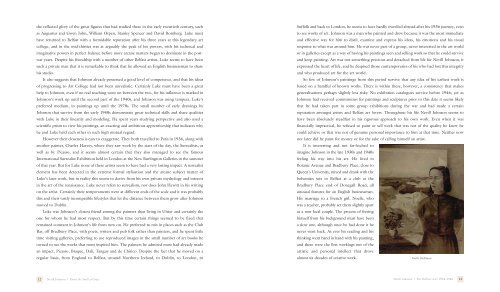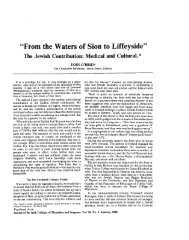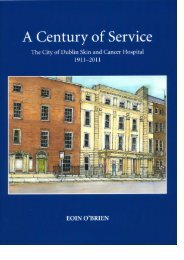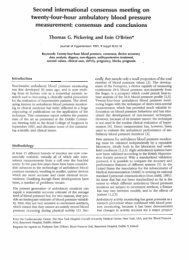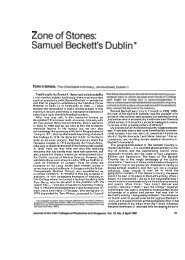Nevill Johnson: Paint the smell of grass - Eoin O'Brien
Nevill Johnson: Paint the smell of grass - Eoin O'Brien
Nevill Johnson: Paint the smell of grass - Eoin O'Brien
Create successful ePaper yourself
Turn your PDF publications into a flip-book with our unique Google optimized e-Paper software.
<strong>the</strong> reflected glory <strong>of</strong> <strong>the</strong> great figures that had studied <strong>the</strong>re in <strong>the</strong> early twentieth century, such<br />
as Augustus and Gwen John, William Orpen, Stanley Spencer and David Bomberg. Luke must<br />
have returned to Belfast with a formidable reputation after his three years at this legendary art<br />
college, and in <strong>the</strong> mid-thirties was at arguably <strong>the</strong> peak <strong>of</strong> his powers, with his technical and<br />
imaginative powers in perfect balance before more arcane matters began to dominate in <strong>the</strong> postwar<br />
years. Despite his friendship with a number <strong>of</strong> o<strong>the</strong>r Belfast artists, Luke seems to have been<br />
such a private man that it is remarkable to think that he allowed an English businessman to share<br />
his studio.<br />
It also suggests that <strong>Johnson</strong> already possessed a good level <strong>of</strong> competence, and that his ideas<br />
<strong>of</strong> progressing to Art College had not been unrealistic. Certainly Luke must have been a great<br />
help to <strong>Johnson</strong>, even if no real teaching went on between <strong>the</strong> two, for his influence is marked in<br />
<strong>Johnson</strong>’s work up until <strong>the</strong> second part <strong>of</strong> <strong>the</strong> 1940s, and <strong>Johnson</strong> was using tempera, Luke’s<br />
preferred medium, in paintings up until <strong>the</strong> 1970s. The small number <strong>of</strong> early drawings by<br />
<strong>Johnson</strong> that survive from <strong>the</strong> early 1940s demonstrate great technical skills and share qualities<br />
with Luke in <strong>the</strong>ir linearity and modeling. He spent years studying perspective and also used a<br />
scientific prism to view his paintings, an exacting and ambitious apprenticeship that indicates why<br />
he and Luke held each o<strong>the</strong>r in such high mutual regard.<br />
However <strong>the</strong>ir closeness is easy to exaggerate. They both travelled to Paris in 1936, along with<br />
ano<strong>the</strong>r painter, Charles Harvey, where <strong>the</strong>y saw work by <strong>the</strong> stars <strong>of</strong> <strong>the</strong> day, <strong>the</strong> Surrealists, as<br />
well as by Picasso, and it seems almost certain that <strong>the</strong>y also managed to see <strong>the</strong> famous<br />
International Surrealist Exhibition held in London at <strong>the</strong> New Burlington Galleries in <strong>the</strong> summer<br />
<strong>of</strong> that year. But for Luke none <strong>of</strong> <strong>the</strong>se artists seem to have had a very lasting impact. A surrealist<br />
element has been detected in <strong>the</strong> extreme formal stylisation and <strong>the</strong> arcane subject matter <strong>of</strong><br />
Luke’s later work, but in reality this seems to derive from his own private mythology and interest<br />
in <strong>the</strong> art <strong>of</strong> <strong>the</strong> renaissance. Luke never refers to surrealism, nor does John Hewitt in his writing<br />
on <strong>the</strong> artist. Certainly <strong>the</strong>ir temperaments were at different ends <strong>of</strong> <strong>the</strong> scale and it was probably<br />
this and <strong>the</strong>ir vastly incompatible lifestyles that let <strong>the</strong> distance between <strong>the</strong>m grow after <strong>Johnson</strong><br />
moved to Dublin.<br />
Luke was <strong>Johnson</strong>’s closest friend among <strong>the</strong> painters <strong>the</strong>n living in Ulster and certainly <strong>the</strong><br />
one for whom he had most respect. But by this time certain things seemed to be fixed that<br />
remained constant in <strong>Johnson</strong>’s life from now on. He preferred to mix in places such as <strong>the</strong> Club<br />
Bar, <strong>of</strong>f Bradbury Place, with poets, writers and pub folk ra<strong>the</strong>r than painters, and he spent little<br />
time visiting galleries, preferring to use reproduced images in <strong>the</strong> small number <strong>of</strong> art books he<br />
owned to see <strong>the</strong> works that most inspired him. The painters he admired most had already made<br />
an impact, Picasso, Braque, Dali, Tanguy and de Chirico. Despite <strong>the</strong> fact that he moved on a<br />
regular basis, from England to Belfast, around Nor<strong>the</strong>rn Ireland, to Dublin, to London, to<br />
12 <strong>Nevill</strong> <strong>Johnson</strong> l <strong>Paint</strong> <strong>the</strong> Smell <strong>of</strong> Grass<br />
Suffolk and back to London, he seems to have hardly travelled abroad after his 1936 journey, even<br />
to see works <strong>of</strong> art. <strong>Johnson</strong> was a man who painted and drew because it was <strong>the</strong> most immediate<br />
and effective way for him to distil, examine and express his ideas, his emotions and his visual<br />
response to what was around him. He was never part <strong>of</strong> a group, never interested in <strong>the</strong> art world<br />
or in galleries except as a way <strong>of</strong> having his paintings seen and selling work so that he could survive<br />
and keep painting. Art was not something precious and detached from life for <strong>Nevill</strong> <strong>Johnson</strong>, it<br />
expressed <strong>the</strong> heart <strong>of</strong> life, and he despised those contemporaries <strong>of</strong> his who had lost this integrity<br />
and who produced art for <strong>the</strong> art world.<br />
So few <strong>of</strong> <strong>Johnson</strong>’s paintings from this period survive that any idea <strong>of</strong> his earliest work is<br />
based on a handful <strong>of</strong> known works. There is within <strong>the</strong>se, however, a consistency that makes<br />
generalisations perhaps slightly less risky. No exhibition catalogues survive before 1946, yet as<br />
<strong>Johnson</strong> had received commissions for paintings and sculptures prior to this date it seems likely<br />
that he had taken part in some group exhibitions during <strong>the</strong> war and had made a certain<br />
reputation amongst artists and Belfast art lovers. Throughout his life <strong>Nevill</strong> <strong>Johnson</strong> seems to<br />
have been absolutely steadfast in his rigorous approach to his own work. Even when it was<br />
financially impractical, he refused to paint or sell work that was not <strong>of</strong> <strong>the</strong> quality he knew he<br />
could achieve or that was not <strong>of</strong> genuine personal importance to him at that time. Nei<strong>the</strong>r now<br />
nor later did he paint for money or for <strong>the</strong> sake <strong>of</strong> calling himself an artist.<br />
It is interesting and not far-fetched to<br />
imagine <strong>Johnson</strong> in <strong>the</strong> late 1930s and 1940s<br />
feeling his way into his art. He lived in<br />
Botanic Avenue and Bradbury Place, close to<br />
Queen’s University, mixed and drank with <strong>the</strong><br />
bohemian sets in Belfast at a club at <strong>the</strong><br />
Bradbury Place end <strong>of</strong> Donegall Road, all<br />
unusual features for an English businessman.<br />
His marriage to a French girl, Noelle, who<br />
was a teacher, probably set <strong>the</strong>m slightly apart<br />
as a non-local couple. The process <strong>of</strong> freeing<br />
himself from his background must have been<br />
a slow one, although once he had done it he<br />
never went back. As ever his reading and his<br />
thinking went hand in hand with his painting,<br />
and <strong>the</strong>re were <strong>the</strong> first workings out <strong>of</strong> <strong>the</strong><br />
artistic and personal intellect that drove<br />
almost six decades <strong>of</strong> creative work. Noelle Biehlman<br />
<strong>Nevill</strong> <strong>Johnson</strong> l The Belfast years 1934–1946 13


